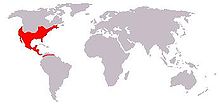Gray fox
| Gray fox | |
|---|---|
 |
|
| Scientific classification | |
| Kingdom: | Animalia |
| Phylum: | Chordata |
| Class: | Mammalia |
| Order: | Carnivora |
| Family: | Canidae |
| Genus: | Urocyon |
| Species: | U. cinereoargenteus |
| Binomial name | |
|
Urocyon cinereoargenteus (Schreber, 1775) |
|
 |
|
| Gray fox range | |
The gray fox (Urocyon cinereoargenteus), or grey fox, is a carnivorous mammal of the family Canidae ranging throughout most of the southern half of North America from southern Canada to the northern part of South America (Venezuela and Colombia). No other canid's natural range spans both North and South America and it is the only American canid that can climb trees. This species and its only congener, the diminutive Channel Island fox (Urocyon littoralis), are the only living members of the genus Urocyon, which is considered to be the most basal of the living canids. Though it was once the most common fox in the eastern United States, and still is found there, human advancement and deforestation allowed the red fox to become more dominant. The Pacific States still have the gray fox as a dominant. Its specific epithet cinereoargenteus means " silver".
The gray fox appeared in North America during the mid-Pliocene epoch 3.6 million years ago (AEO) with the first fossil evidence found at the lower 111 Ranch site, Graham County, Arizona with contemporary mammals like the giant sloth, the elephant-like Cuvieronius, the large-headed llama, and the early small horses of Nannippus and Equus. Genetic analyses of the fox-like canids confirmed that the gray fox is a distinct genus from the red foxes (Vulpes spp.). Genetically, the gray fox often clusters with two other ancient lineages, the east Asian raccoon dog (Nyctereutes procyonoides) and the African bat-eared fox (Otocyon megalotis). Chromosome number is 2n=66. Faunal remains at two northern California cave sites confirm the presence of the gray fox during the late . Genetic analysis has shown that the gray fox migrated into the northeastern United States post-Pleistocene in association with the Medieval Climate Anomaly warming trend. Recent mitochondrial genetic studies suggests divergence of North American eastern and western gray foxes in the Irvingtonian mid-Pleistocene into separate sister taxa.
...
Wikipedia

